flink dataset api使用及原理
随着大数据技术在各行各业的广泛应用,要求能对海量数据进行实时处理的需求越来越多,同时数据处理的业务逻辑也越来越复杂,传统的批处理方式和早期的流式处理框架也越来越难以在延迟性、吞吐量、容错能力以及使用便捷性等方面满足业务日益苛刻的要求。
在这种形势下,新型流式处理框架Flink通过创造性地把现代大规模并行处理技术应用到流式处理中来,极大地改善了以前的流式处理框架所存在的问题。
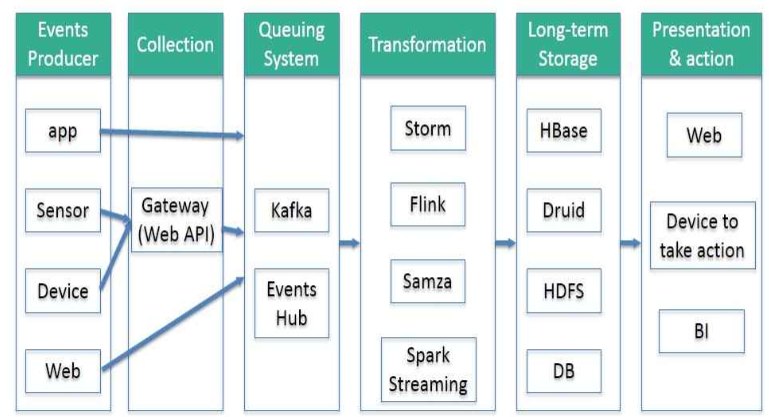
1.概述:
flink提供DataSet Api用户处理批量数据。flink先将接入数据转换成DataSet数据集,并行分布在集群的每个节点上;然后将DataSet数据集进行各种转换操作(map,filter等),最后通过DataSink操作将结果数据集输出到外部系统。
2.数据接入
输入InputFormat
/**
* The base interface for data sources that produces records.
* <p>
* The input format handles the following:
* <ul>
* <li>It describes how the input is split into splits that can be processed in parallel.</li>
* <li>It describes how to read records from the input split.</li>
* <li>It describes how to gather basic statistics from the input.</li>
* </ul>
* <p>
* The life cycle of an input format is the following:
* <ol>
* <li>After being instantiated (parameterless), it is configured with a {@link Configuration} object.
* Basic fields are read from the configuration, such as a file path, if the format describes
* files as input.</li>
* <li>Optionally: It is called by the compiler to produce basic statistics about the input.</li>
* <li>It is called to create the input splits.</li>
* <li>Each parallel input task creates an instance, configures it and opens it for a specific split.</li>
* <li>All records are read from the input</li>
* <li>The input format is closed</li>
* </ol>
* <p>
* IMPORTANT NOTE: Input formats must be written such that an instance can be opened again after it was closed. That
* is due to the fact that the input format is used for potentially multiple splits. After a split is done, the
* format's close function is invoked and, if another split is available, the open function is invoked afterwards for
* the next split.
*
* @see InputSplit
* @see BaseStatistics
*
* @param <OT> The type of the produced records.
* @param <T> The type of input split.
*/
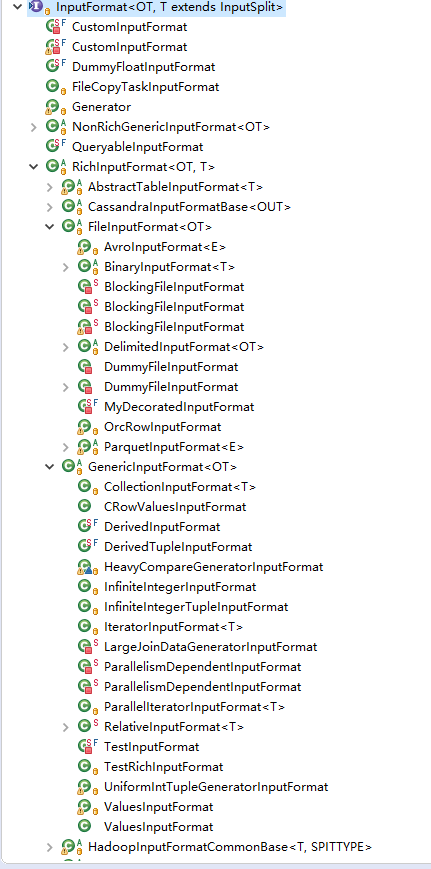
3.数据转换
DataSet:一组相同类型的元素。DataSet可以通过transformation转换成其它的DataSet。示例如下:
DataSet#map(org.apache.flink.api.common.functions.MapFunction)
DataSet#reduce(org.apache.flink.api.common.functions.ReduceFunction)
DataSet#join(DataSet)
DataSet#coGroup(DataSet)
其中,Function:用户定义的业务逻辑,支持java 8 lambda表达式
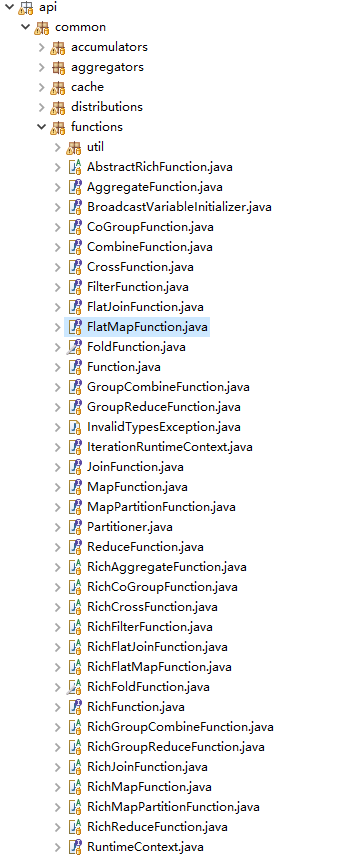
function的实现通过operator来做的,以map为例
/**
* Applies a Map transformation on this DataSet.
*
* <p>The transformation calls a {@link org.apache.flink.api.common.functions.MapFunction} for each element of the DataSet.
* Each MapFunction call returns exactly one element.
*
* @param mapper The MapFunction that is called for each element of the DataSet.
* @return A MapOperator that represents the transformed DataSet.
*
* @see org.apache.flink.api.common.functions.MapFunction
* @see org.apache.flink.api.common.functions.RichMapFunction
* @see MapOperator
*/
public <R> MapOperator<T, R> map(MapFunction<T, R> mapper) {
if (mapper == null) {
throw new NullPointerException("Map function must not be null.");
} String callLocation = Utils.getCallLocationName();
TypeInformation<R> resultType = TypeExtractor.getMapReturnTypes(mapper, getType(), callLocation, true);
return new MapOperator<>(this, resultType, clean(mapper), callLocation);
}
其中,Operator
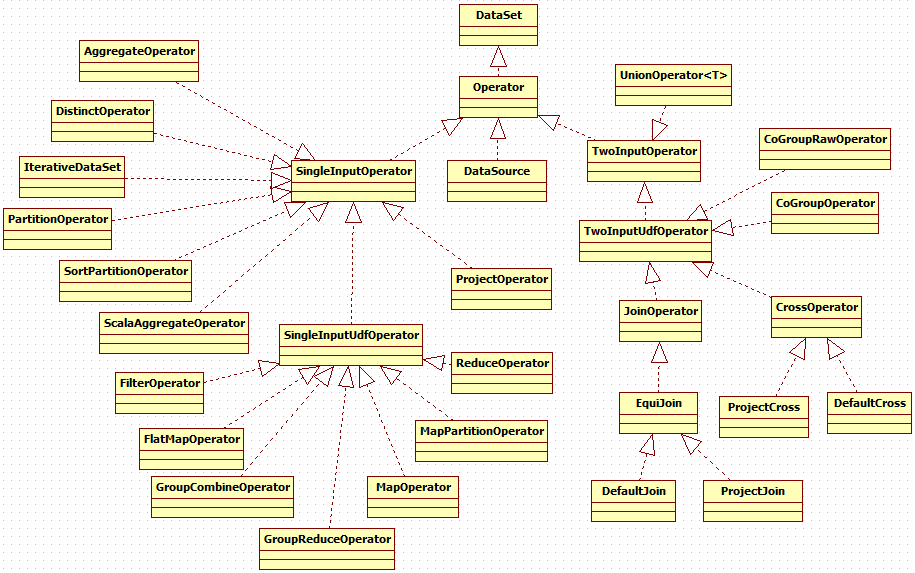
4.数据输出
DataSink:一个用来存储数据结果的操作。
输出OutputFormat
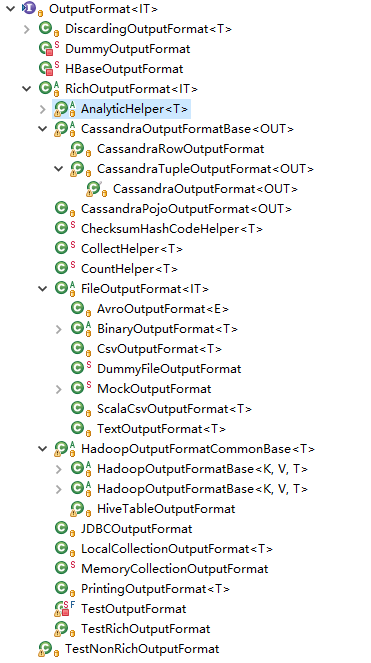
例如,可以csv输出
/**
* Writes a {@link Tuple} DataSet as CSV file(s) to the specified location with the specified field and line delimiters.
*
* <p><b>Note: Only a Tuple DataSet can written as a CSV file.</b>
* For each Tuple field the result of {@link Object#toString()} is written.
*
* @param filePath The path pointing to the location the CSV file is written to.
* @param rowDelimiter The row delimiter to separate Tuples.
* @param fieldDelimiter The field delimiter to separate Tuple fields.
* @param writeMode The behavior regarding existing files. Options are NO_OVERWRITE and OVERWRITE.
*
* @see Tuple
* @see CsvOutputFormat
* @see DataSet#writeAsText(String) Output files and directories
*/
public DataSink<T> writeAsCsv(String filePath, String rowDelimiter, String fieldDelimiter, WriteMode writeMode) {
return internalWriteAsCsv(new Path(filePath), rowDelimiter, fieldDelimiter, writeMode);
} @SuppressWarnings("unchecked")
private <X extends Tuple> DataSink<T> internalWriteAsCsv(Path filePath, String rowDelimiter, String fieldDelimiter, WriteMode wm) {
Preconditions.checkArgument(getType().isTupleType(), "The writeAsCsv() method can only be used on data sets of tuples.");
CsvOutputFormat<X> of = new CsvOutputFormat<>(filePath, rowDelimiter, fieldDelimiter);
if (wm != null) {
of.setWriteMode(wm);
}
return output((OutputFormat<T>) of);
}
5.总结
1. flink通过InputFormat对各种数据源的数据进行读取转换成DataSet数据集
2. flink提供了丰富的转换操作,DataSet可以通过transformation转换成其它的DataSet,内部的实现是Function和Operator。
3. flink通过OutFormat将DataSet转换成DataSink,最终将数据写入到不同的存储介质。
参考资料:
【1】https://blog.51cto.com/13654660/2087705
flink dataset api使用及原理的更多相关文章
- flink DataStream API使用及原理
传统的大数据处理方式一般是批处理式的,也就是说,今天所收集的数据,我们明天再把今天收集到的数据算出来,以供大家使用,但是在很多情况下,数据的时效性对于业务的成败是非常关键的. Spark 和 Flin ...
- Flink DataSet API Programming Guide
https://ci.apache.org/projects/flink/flink-docs-release-0.10/apis/programming_guide.html Example ...
- Apache Flink - Batch(DataSet API)
Flink DataSet API编程指南: Flink中的DataSet程序是实现数据集转换的常规程序(例如,过滤,映射,连接,分组).数据集最初是从某些来源创建的(例如,通过读取文件或从本地集合创 ...
- Flink入门(五)——DataSet Api编程指南
Apache Flink Apache Flink 是一个兼顾高吞吐.低延迟.高性能的分布式处理框架.在实时计算崛起的今天,Flink正在飞速发展.由于性能的优势和兼顾批处理,流处理的特性,Flink ...
- Apache Flink 1.12.0 正式发布,DataSet API 将被弃用,真正的流批一体
Apache Flink 1.12.0 正式发布 Apache Flink 社区很荣幸地宣布 Flink 1.12.0 版本正式发布!近 300 位贡献者参与了 Flink 1.12.0 的开发,提交 ...
- Flink整合面向用户的数据流SDKs/API(Flink关于弃用Dataset API的论述)
动机 Flink提供了三种主要的sdk/API来编写程序:Table API/SQL.DataStream API和DataSet API.我们认为这个API太多了,建议弃用DataSet API,而 ...
- 【翻译】Flink Table Api & SQL — 用户定义函数
本文翻译自官网:User-defined Functions https://ci.apache.org/projects/flink/flink-docs-release-1.9/dev/tabl ...
- 8、Flink Table API & Flink Sql API
一.概述 上图是flink的分层模型,Table API 和 SQL 处于最顶端,是 Flink 提供的高级 API 操作.Flink SQL 是 Flink 实时计算为简化计算模型,降低用户使用实时 ...
- 统一批处理流处理——Flink批流一体实现原理
实现批处理的技术许许多多,从各种关系型数据库的sql处理,到大数据领域的MapReduce,Hive,Spark等等.这些都是处理有限数据流的经典方式.而Flink专注的是无限流处理,那么他是怎么做到 ...
随机推荐
- redis SERVER INSTALL WINDOWS SERVICE
以管理 员身份 运行 CMD 命令,进入redis所在目录,并运行下 脚本redis-server --service-install redis.windows-service.conf --log ...
- 简单易用的MongoDB
从我第一次听到Nosql这个概念到如今已经走过4个年头了,但仍然没有具体的去做过相应的实践.最近获得一段学习休息时间,购买了Nosql技术实践一书,正在慢慢的学习.在主流观点中,Nosql大体分为4类 ...
- Win8 Metro(C#)数字图像处理--2.52图像K均值聚类
原文:Win8 Metro(C#)数字图像处理--2.52图像K均值聚类 [函数名称] 图像KMeans聚类 KMeansCluster(WriteableBitmap src,i ...
- Win8Metro(C#)数字图像处理--2.15图像霓虹效果
原文:Win8Metro(C#)数字图像处理--2.15图像霓虹效果 [函数名称] 图像霓虹效果函数NeonProcess(WriteableBitmap src) 上述公式进行开方即可. [函 ...
- oracle 12c连接pdb
12c中,如何连接pluggable database: 使用默认的service连接pdb,创建pdb之后,在监听中自动添加以pdb为名的service: 用户在cluster中创建service, ...
- Tensorflow中循环神经网络及其Wrappers
tf.nn.rnn_cell.LSTMCell 又名:tf.nn.rnn_cell.BasicLSTMCell.tf.contrib.rnn.LSTMCell 参见: tf.nn.rnn_cell.L ...
- Linux ADF(Atomic Display Framework)浅析---概述
概述 因为工作关系,最近有涉及到ADF(Atomic Display Framework)相关的内容,部分内容来自互联网 ADF(Atomic Display Framework)是Google新增的 ...
- 用python的curl和lxml来抓取和分析网页内容
Curl是一个强大的URL语法的客户端,支持DICT, FILE, FTP, FTPS, Gopher, HTTP, HTTPS, IMAP, IMAPS, LDAP, LDAPS, POP3, PO ...
- Ring3下无驱动移除winlogon.exe进程ctrl+alt+del,win+u,win+l三个系统热键,非屏蔽热键(子类化SAS 窗口)
随手而作,纯粹技术研究,没什么实际意义. 打开xuetr,正常情况下.winlogon.exe注册了三个热键.ctrl+alt+del,win+u,win+l三个. 这三个键用SetWindowsHo ...
- Codility---CountFactors
Task description A positive integer D is a factor of a positive integer N if there exists an integer ...
